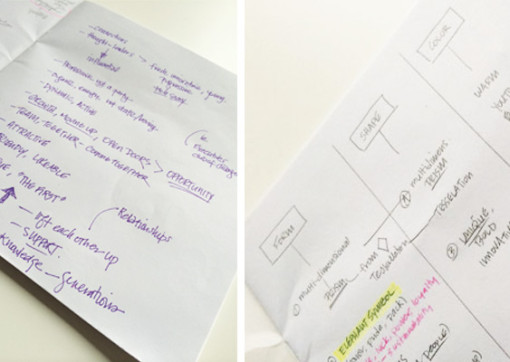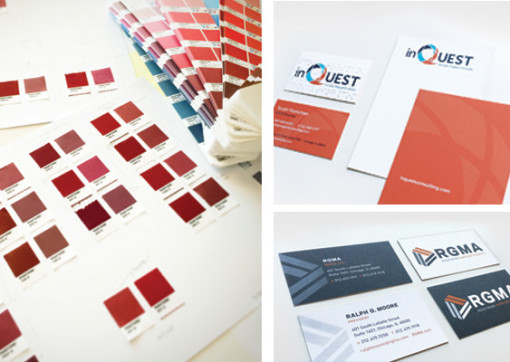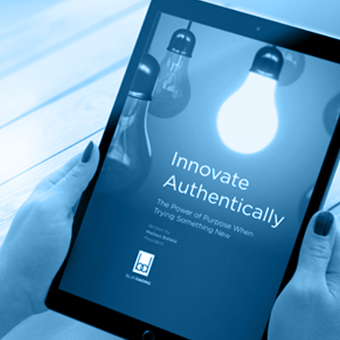Every designer has his or her own way of designing a logo. This year, I’ve paid particular attention to my own creative process. Partly to see if I could establish a more systematic way of creating, but also to archive the experience from start to finish.
Most people only ever see the finished product, but there is so much that goes untold for each unique logo. Designers don’t just go back to their computers and crank out a bunch of nice looking symbols. The logo design process for each brand has its own story to tell.
1 Have a conversation.
At Blue Daring, every brand begins with a strategy. Before we even think about form or color, we need to have a strategic understanding of our clients’ business. From their values to their products, services, culture and people—we discover everything there is to know about our clients in order to craft a meaningful story around their brand. Once we have the strategic direction mapped out, we invite our clients to our office for a BLUEprint.
“Through creative exercises and strategic questions, a BLUEprint sparks aesthetic ideas and values-focused creative thinking that we can build a logo around.”

2 Start with words.
I believe that what a logo means is more important than what it actually looks like. This is not say that a logo doesn’t have to be beautifully designed. Of course it does.
“What a logo means is more important than what it actually looks like.”
For me, I start by focusing on the story that I am eventually going to tell in visual form. This story is built from both the strategy and what was revealed in the BLUEprint. I usually do a free association exercise where I write down as many words that come to mind to describe the company, it’s values, what the logo should convey, how it should feel, etc. From the plethora of words, I nail down three ideas that the logo must convey and conceptualize them in design terms—form, color, shape, etc.

3 Sketch, sketch, sketch. Then sketch some more.
The goal is to draw as many ideas, logos and forms as possible because even the best sketches can fail in execution and
“the ugliest scribbles can become the most brilliant concepts. The key is QUANTITY, not quality.”
This is the part of the process that is the most creative, rewarding, and organic—but also the most challenging and gives me grey hairs. I spend days, late nights and random moments trying to come up with completely unique and brilliant ideas, metaphors, and symbols that can manifest themselves in a distinct mark. Trying to avoid clichés and think of the unexpected, the uncommon. It is crazy where and when ideas come to me. Sometimes as I’m about to fall asleep, BAM! I’ve got it. And I start sketching away. Once I dreamt that one of our clients was an animal talking to me and from that I woke up with a brilliant idea for their logo. And of course sometimes I go through weeks of dry spells where I have no clue what I am going to do. (That’s where the grey hairs come in). I always say the best and worst part of being a creative is that you have to create the solution.

4 Get on the computer.
After selecting 2-3 of the best ideas from the various concepts, I do a final drawing, then scan and begin to vectorize in Illustrator.
“If nothing works, I go back to sketching, then back to the computer, then back to sketching—toggling between drawing and pushing pixels until I get it right.”

5 Develop brand identity.
After the client has made a selection we create the remaining brand elements (patterns, textures, images and messaging), select brand colors and fonts (PMS and web), and create the identity collateral (business cards, letterhead, etc.)
“The final step is to create brand guidelines that will preserve the integrity of the new brand.”

So we’re done? We’ve got a brand now?
Not quite. Why? Because…
“a brand is not a logo and a logo is not a brand.”
A logo is only the beginning of a brand’s life—much like naming a newborn. A brand is not something you can create and be done with. The logo, like a person’s name, is just a small part of their identity. Much like raising a child, a brand’s potential will be revealed throughout its life. For a brand this depends on how well it is strategically executed (through storytelling and touchpoints) and how effectively it is able to be adopted by its audience (through consistency, frequency and relevance).
Congratulations! You’ve just given birth to a beautiful baby BRAND, now time to raise it! How? Well that sounds like another blog post….
 More than Sauce: Branding Diversity
More than Sauce: Branding Diversity  Getting the Most Out of Conferences
Getting the Most Out of Conferences  Innovate Authentically: The importance of purpose when trying something new
Innovate Authentically: The importance of purpose when trying something new